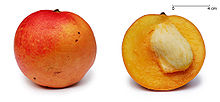Recalcitrant seed

Recalcitrant seeds are
Nymphaea caerulea[3], and several plants used in traditional medicine, such as species of Virola and Pentaclethra. Generally speaking, most tropical pioneer species have orthodox seeds but many climax species have recalcitrant or intermediate seeds.[4]
Mechanisms of damage

The two main mechanisms causing damage to recalcitrant seeds are
free radicals.[5] An example of the first type of damage would be found in some recalcitrant nontropical hardwood seeds, specifically the acorns of recalcitrant oaks, which can be stored in a non-frozen state for up to two years provided that precautions are taken against drying. These seeds show deterioration of cell membrane lipids and proteins after as few as 3–4 days of drying.[6] Other recalcitrant seeds, such as those of the sweet chestnut (Castanea sativa), show oxidative damage resulting from uncontrolled metabolism occurring during the drying process.[7]
Storage
Preservation of recalcitrant seeds remains experimental. Some approaches include:
- Removal of the embryo inside for cryopreservation (liquid nitrogen).[8]
- Cryopreservation of the whole seed in an anti-freezing solution.[3]
Intermediate seeds are between orthodox and recalcitrant seeds in their survivablity. They are initially identified by their inability to survive conventional dry-freezing storage while being able to survive cryopreservation as a whole. The storage guideline is to put them in refrigeration at 45–65% RH, for a maximum of five years.[8]
See also
References
- ^ "Frequently Asked Questions". National Center for Genetic Resources Preservation, USDA. Archived from the original on August 19, 2007. Retrieved 2008-01-09.
- ^ Marcos-Filho, Julio. "Physiology of Recalcitrant Seeds" (PDF). Ohio State University. Archived from the original (PDF) on January 24, 2014. Retrieved December 3, 2014.
- ^ a b Lee, Chung-Hao (2016). Cryopreservation of seeds of blue waterlily (Nymphaea caerulea) using glutathione adding plant vitrification solution, PVS+ / 埃及藍睡蓮種子的冷凍保存 — 使用添加穀胱甘肽的植物抗凍配方 (PDF). National Tsing Hua University.
- ^ Flores, E.M.; J. A. Vozzo Editor. "Ch 1. Seed Biology" (PDF). Tropical Tree Seed Manual. USDA Forest Service. Archived from the original on 2017-07-12. Retrieved 2011-12-24.
{{cite web}}:|author2=has generic name (help) - ^ Berjak, Patricia; N.W. Pammenter; J. A. Vozzo Editor. "Ch 4. Orthodox and Recalcitrant Seeds" (PDF). Tropical Tree Seed Manual. USDA Forest Service. Archived from the original on 2017-07-12. Retrieved 2010-09-27.
{{cite web}}:|author3=has generic name (help) - ^ Connor, Kristina F (2004). "Update on oak seed quality research: Hardwood recalcitrant seeds". Proc. RMRS. P (33). USDA, Rocky Mountain Research Station: 111–116. Archived from the original on 2017-07-02. Retrieved 2008-01-09.
- .
- ^ a b "Orthodox, Intermediate, and Recalcitrant Seed". Center for Plant Conservation.
